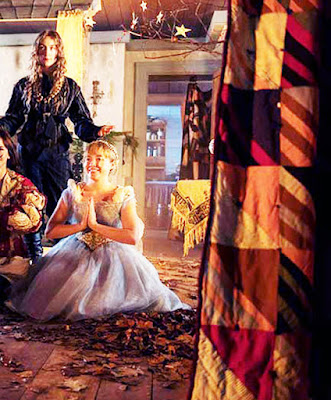Here's Laura Dern playing Marmee in the recent Little Women.
Looks good for the early 1860s in Massachusetts, a period woven coverlet in indigo and madder,
painted walls, a theorem for decoration. Those are awfully fluffy pillows but that's a minor detail. The costumer won an Academy Award for the garments.
Looking around for some stills.
Is that a cat made out of an old crazy quilt in Amy's room?
I'm afraid so. Crazy quilts after 1880;
old crazy quilts cut up to make cats?
1970?
Okay the quilts are all wrong. The strip comforter with ties above looks
early 20th century. Several movie goers with good eyes noted glimpses
of post 1880-crazy quilts.
On the chair on the right, a quilt made out of a piece of cheater cloth.
And what is that on the wall! William Morris wallpaper.
Cheater cloth, mid 1880s.
William Morris style wallpaper. This is Pimpernel
designed in 1876.
So why don't they ask somebody like moi to advise them on accuracy? Actually I have worked as a historical adviser on a movie set in the 1860s. They went with William Morris wallpaper too.
The set designer and production designer are going for a look that is going to sell. They seem to love lavish layers of late Victorian textiles. Movies are entertainment, not house museums.
1854 The New Bonnet, Francis William Edmonds.
True Civil War interiors are rather austere, particularly for people as poor and as ascetic as the Alcott/March family.
1857 Time to Go by Edmonds.
White wash the walls say I. Put up a clock shelf and throw a few rag rugs on the floor.
But whitewashed walls just don't make it.
A movie is not a museum. It's entertainment.
And so is nitpicking. If you are going to have pattern
remember that in the 1860s repetitious spotty designs were all the rage.
The half drop, diagonal repeat.
Which is why the complex repeat of William Morris paper was so novel twenty years later.
And set designers love it so.




















































